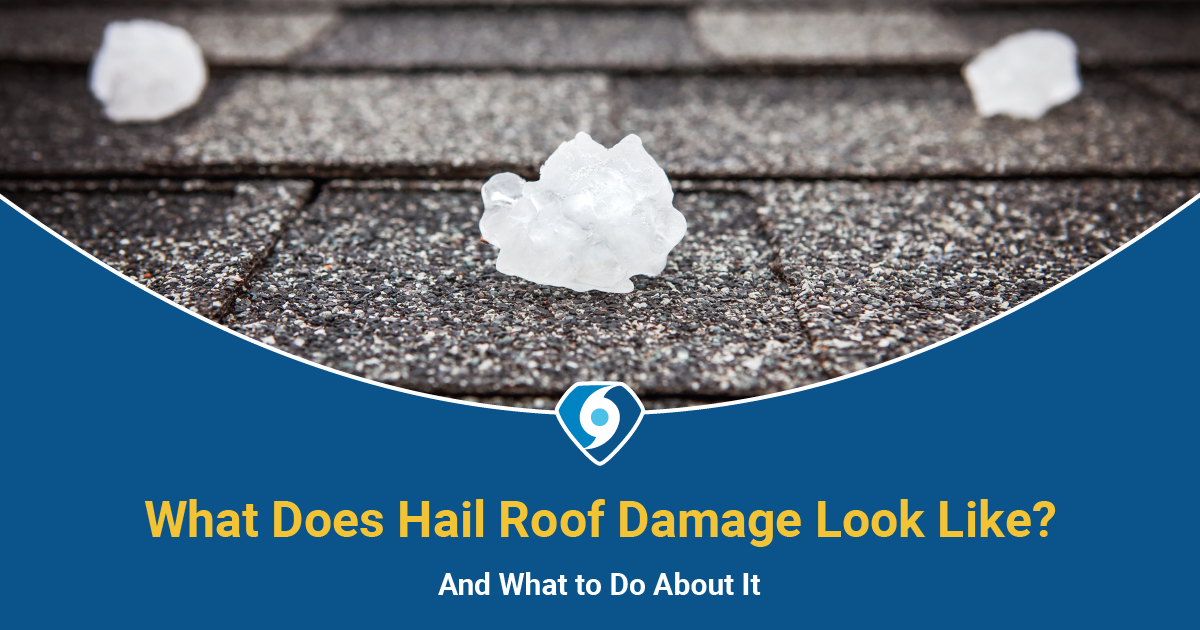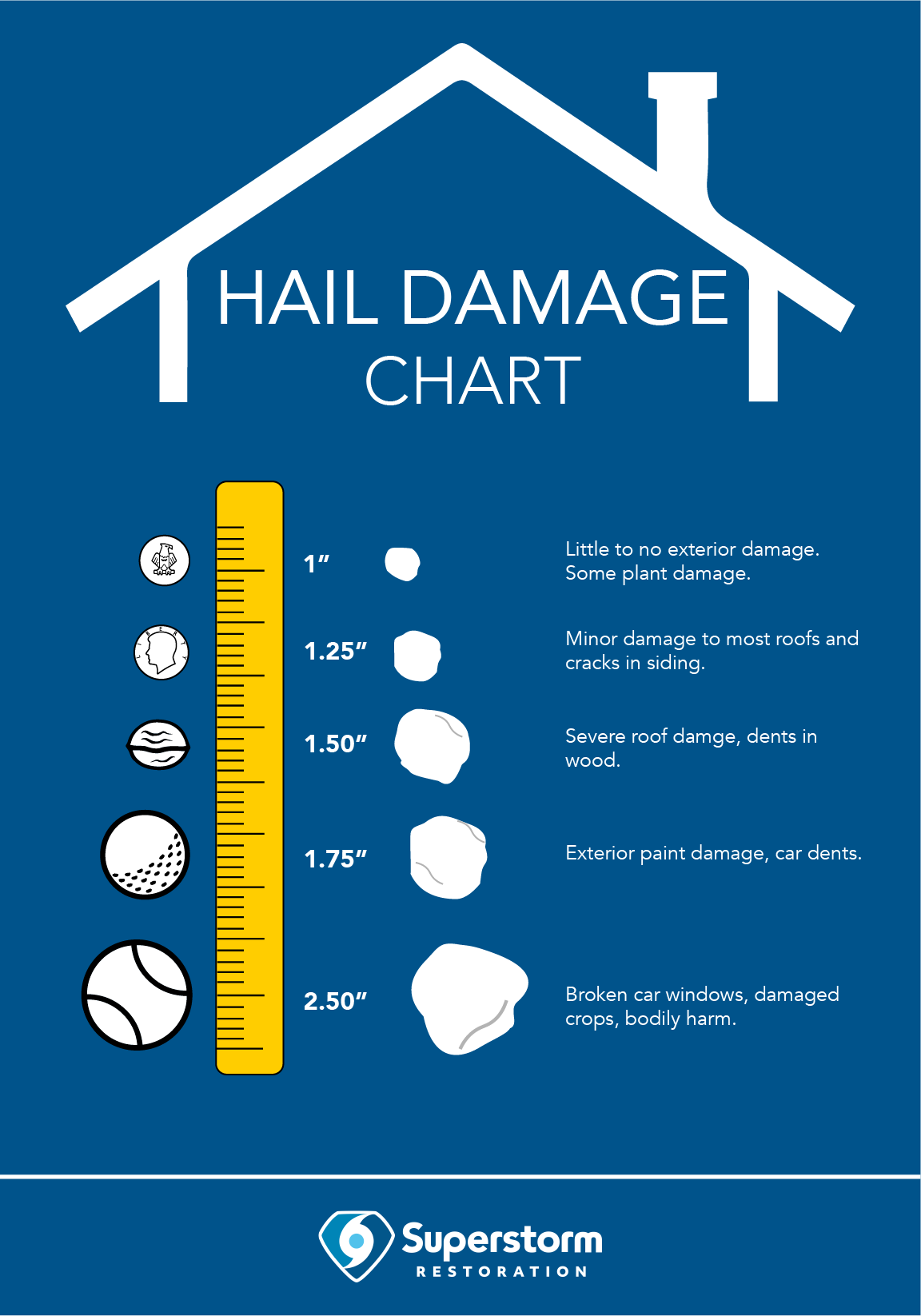
What Does Hail Damage Do to a Roof
In 2022, there were over 4,400 severe hail reports, resulting in billions in dollars in property damage. State Farm reported a $1 billion increase in hail claim costs due to the increased number of hail storms in 2022.
The costs associated with hail damage can quickly add up because hail affects just about anything outside, including your car, your windows and your roof. Some signs of hail damage are obvious, like a broken window or a dented car. But it’s the small, unnoticeable damage from hail that takes a trained eye to spot. Even if you don’t have obvious holes in your roof due to hail damage, you likely still need a hail damage roof inspection to find out how much damage you’re dealing with and how to proceed with any roof repairs needed.

What hail does to a roof
The effects of hail roof damage can differ according to a range of factors: hail size, wind speed, wind direction, the material of the roof, age of materials and slope all have an effect on the possible roof damage that occurs during a hail storm. Hail damage is bad for a roof when it leads to roof leaks and other issues. Damage can be functional or cosmetic, and it’s the cosmetic damage that is sometimes more severe than it looks. Things like broken edges, bruises, punctures and granule loss can cause serious complications, though they may seem cosmetic at first.
Hail Damage to Asphalt and Composition Shingles
Granule loss
- Granules are the sandpaper-like part of the shingle. When a shingle loses granules, its asphalt coating is exposed to the elements, and this leads to accelerated aging. Take a look in your gutters and downspouts after a hailstorm to see if any granules have come off your shingles.
Cracks in the shingles
- Hard hail impacts or high winds can grip the shingles and cause cracks. This can lead to exposure and tears, leaving your roof with bare spots. Cracked shingles cannot effectively protect your roof from the weather.
Exposed fiberglass mat
- Hail impact on a roof can shatter the shingles’ surfacing, causing it to break away from the fiberglass mat underneath.
Fractured fiberglass mat
- Fractured fiberglass can be slightly harder to detect and usually requires a trained eye. Fractured fiberglass mats can result in tears and cracks from a point of hail impact.
Weakened self-seal strip
- High winds and hail can weaken the seal integrity of your shingles. A weakened seal is what causes a shingle to blow off and can leave your roof exposed to the elements. Once a shingle is damaged, its integrity has been permanently compromised. This can lead to leaks, and it can cause other shingles around it to tear.
Once you know about these common forms of hail roof damage, you can start to look for signs of damage on your property after a hailstorm.
How do you know if your roof or exterior has hail damage?
Determining whether your roof or exterior has hail damage can be challenging, especially if the damage is minor and not easily visible to an untrained eye. However, there are several key indicators to look for or follow our helpful tips. Firstly, inspect your gutters and downspouts, as high-impact hail is likely to dent them. Dents and dings on these areas often suggest roof damage. Additionally, check if your gutters are clogged or overflowing, as granules shed from shingles during a hailstorm can cause blockages. Another area to examine is your siding, which can show signs of hail damage. Lastly, your deck may also exhibit damage from a severe hailstorm, serving as an indicator for potential shingle damage. If any of these areas display hail damage, it is advisable to seek a professional roof inspection for a comprehensive assessment.
Can 1 inch hail cause damage to a roof?
Yes! In fact, even hail smaller than 1 inch can cause damage to a roof or to other areas of your house. After a hailstorm, the size of the hail can be the easiest indicator as to what types of damage you may face. While not a foolproof method for predicting storm damage, understanding the various sizes of hail and how they affect your home is a great place to start.
¾” Hail
Though the smallest hail we measure, ¾” hail can still be damaging depending on accompanying wind speeds. Hail this size typically damages vinyl siding, window screens, metal fascia and paint on a deck. We also see it dislodge granules from asphalt shingles and damage gutters and downspouts. Because of its smaller size, property owners often fail to identify the damages associated with hail under one inch.
1” Hail
Once we hit the 1” mark, we start to see bruising to shingle underlayment and significant damage to siding, gutters and fascia. Wind speeds will determine the severity of damage, and you will also see roof damage similar to damage caused by smaller sizes of hail.
1¼” Hail
With only a ¼” increase, the severity of this size of hail is much more significant. Parts of your property exposed to hail have the potential to look like swiss cheese. Even without wind, we’ll see this hail cause damage by simply falling out of the sky.
1½” Hail
This size of hail causes significant damage to property. Depending on the amount of hail, the length of time it falls and the accompanying wind speeds, damage to your property could be severe.
1¾ - 2” Hail
Now we’re getting to the size where the hail can penetrate softer parts of a roof, such as ridge caps or plastic roof vents. Combined with wind, this size of hail can tear siding completely off of a house, crack windows and damage most types of metal fixtures.
2” Hail
Anything this size or above will cause significant and severe damage to your property. We are no longer asking “if” you have property damage, but “where” you have property damage. It’s suggested that you call a roofing contractor with insurance experience immediately after this type of storm event.
What does roof damage from hail look like?
If a storm brings hail that is over one inch in diameter, the hail damage to your roof will probably be obvious. When hail is combined with high wind speeds, roof damage can be even more severe. It’s likely that you will be able to see signs of damage such as cracked or broken windows, damaged siding or dented gutters. Smaller hail can cause unseen damage to your roof, so make sure you contact a
storm damage repair team to inspect your roof after a hailstorm - no matter how small the hail was.
While these are the common types of damage we see on asphalt shingles, hail can crack or even shatter harder materials like clay or concrete. This type of damage will be easy to see, but when you consider something like hail impact marks, you really start to see how a roofing expert can help spot small, important details.


Can Hail Damage to a Roof be Repaired?
Yes! Depending on the extent of the damage, repairing a roof damaged by hail can be as simple as fixing a single shingle or as involved as replacing the whole roof. This vast difference in repair options is why we suggest everyone have their roof inspected by a professional after a big hailstorm. An experienced roofer can quickly determine the severity of the damage.
Most roof inspections are also free, giving you a no-cost solution if you think your roof has been damaged during a recent or past storm. If you’re unsure on whether you need a hail damage roof inspection, look for signs of damage like the ones noted above. If you are finding more than one instance of a dented gutter or damage to your siding, you should seriously consider a hail damage roof inspection. As we mentioned before, shingle damage can be severe or relatively mild. While it’s easy to tell when severe damage has occurred, it’s more important to understand the mild damage and decide what kind of hail damage roof repairs may be needed.
What Happens When You Ignore Roof Repairs?
When ignored, shingle and roof damage can quickly turn into leaks or ice dams. These eventually turn into mold damage, electrical issues, or rotting wood — all of which are expensive to fix.
Wood rot and mold, for example, can spiral out of control and are hard to detect until it’s almost too late. Being proactive about potential issues like these can save you thousands of dollars and keep your home in great condition.
Handling Hail Roof Damage
After you have decided what to do and if your home was damaged, it’s important to find a roofing contractor that you trust and, preferably, one that has experience working on projects for which homeowners have filed insurance claims.
Is a hail damaged roof covered by insurance?
A typical homeowners insurance policy will include coverage for roof damage from hail, but coverage may be applied differently depending on where you live, who your insurer is and the details of your policy.
How long do I have to file an insurance claim for hail damage?
Many insurance companies require you to file a claim within one year after determining that your roof has sustained hail damage. We recommend that you make an appointment to have your roof inspected as soon as possible after you suspect roof damage caused by hail. You want to have plenty of time to review damage assessments as well as any quotes for hail damage roof repairs.
If your home has been affected by hail damage, contact us for a free property evaluation. Our Des Moines roofing experts will help you understand the scope of work that will be required to repair your property, and we will get it looking good as new! Hail yeah!